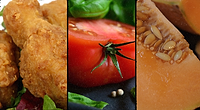IFSAC Releases U.S. Foodborne Illness Source Attribution Estimates for 2022: Salmonella, Listeria, E. coli

Image credit: Freepik
Salmonella illnesses in the U.S. in 2022 were attributed to a wide variety of foods, while Escherichia coli and Listeria monocytogenes infections were mostly linked to two or three food groups, according to the Interagency Food Safety Analytics Collaboration’s (IFSAC’s) latest foodborne illness source attribution report.
IFSAC is a group created by the Centers for Disease Control and Prevention (CDC), the U.S. Food and Drug Administration (FDA), and the U.S. Department of Agriculture's Food Safety and Inspection Service (USDA-FSIS), which brings together data from the three agencies to improve coordination of federal food safety analytic efforts and address cross-cutting priorities for food safety data collection, analysis, and use. Learn how IFSAC strives to improve the data and methods used to estimate the sources of foodborne illnesses in “What Foods Make People Sick? This Federal Collaboration Seeks to Find Out,” written by IFSAC authors for the December ‘24/January ’25 issue of Food Safety Magazine, here.
The dataset analyzed for IFSAC’s 2022 foodborne illness source attribution report includes 48,375 illnesses linked to 1,355 foodborne disease outbreaks that occurred from 1998–2022, and for which each confirmed or suspected implicated food was assigned to a single food category. The method relies most heavily on the last five years of outbreak data (2018–2022). Data was extracted from CDC’s Foodborne Disease Outbreak Surveillance System (FDOSS).
IFSAC’s source attribution work focuses on four priority pathogens: Salmonella, L. monocytogenes, E. coli O157, and Campylobacter. However, attribution estimates for Campylobacter are not presented in the latest report (consistent with the previous year, 2021), due to evidence showing that the sources of Campylobacter outbreaks likely differ considerably from the sources of non-outbreak-associated illnesses caused by this pathogen. IFSAC is exploring alternative approaches for estimating the sources of Campylobacter illnesses.
Foods to which illnesses are attributed in the report are broken up into 17 categories that closely align with the U.S. food regulatory agencies' classification needs. These categories are: dairy, eggs, pork, chicken, turkey, beef, game, other meat/poultry, fish, other seafood, fruits, vegetable row crops, sprouts, seeded vegetables, grains/bean, other produce, and oils/sugars.
Overall, the report whittles the data down to 1,355 outbreaks that occurred from 1998–2022, which were confirmed or suspected to be caused by Salmonella, E. coli O157, or L. monocytogenes, and that could be attributed to a single food category. Of these outbreaks, 1,010 were caused by Salmonella (46 of which were caused by multiple serotypes), 281 by E. coli, and 64 by L. monocytogenes.
More than 75 percent of Salmonella illnesses were attributed to seven food categories: chicken (19.7 percent), fruits (14.6 percent), seeded vegetables (12 percent), pork (11.9 percent), other produce (9.4 percent), beef (6.9 percent), and turkey (5.2 percent).
E. coli illnesses were less evenly distributed, with 85 percent of cases linked to vegetable row crops and beef. Vegetable row crops had a significantly higher estimated attribution percentage (63.7 percent) than other categories—vegetable row crops were followed by beef at 21.4 percent, and then dairy at 3.3 percent. No E. coli illnesses were attributed to eggs or oils/sugars.
More than 75 percent of L. monocytogenes illnesses were caused by dairy (37.3 percent), vegetable row crops (22.6 percent), and fruits (17.3 percent). No illnesses were attributed to other meat/poultry, game, other seafood, grains/beans, oils/sugars, or seeded vegetables.
Looking for a reprint of this article?
From high-res PDFs to custom plaques, order your copy today!






